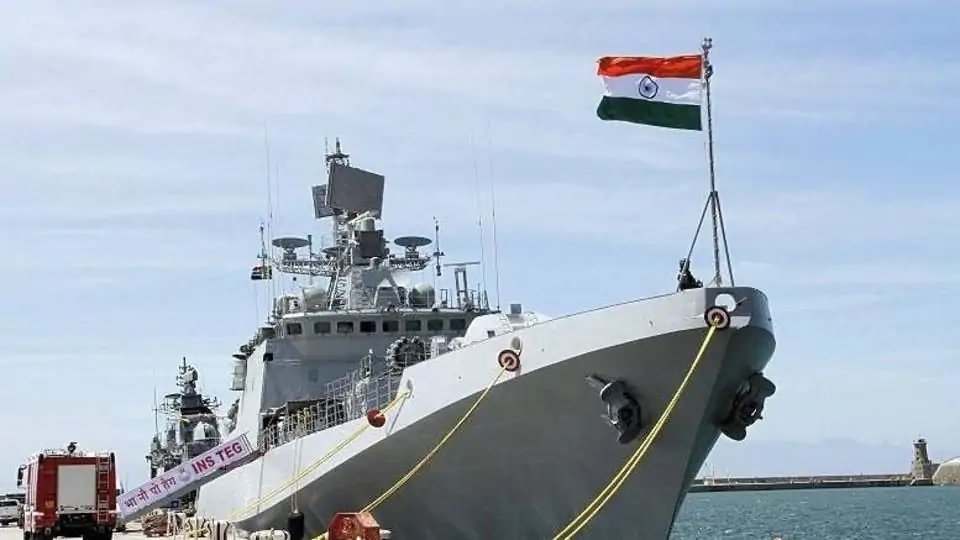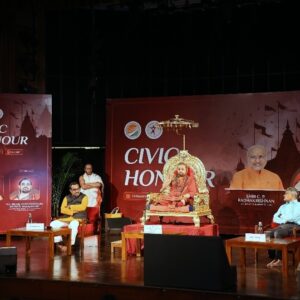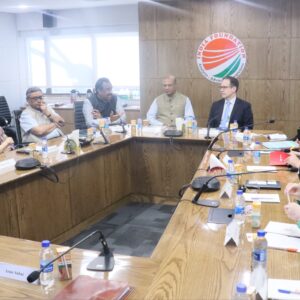India’s Flag is oft called the Tricolour, for its three horizontal stripes in colours of saffron, white and green. But what is often missed is the fourth colour in the flag—the blue wheel in the centre. Prime Minister Narendra Modi made reference to this, in an address he delivered at the commissioning of the ‘Barracuda’ in Mauritius on 12 March 2015. Referring to the blue wheel, he said, “To me, the blue chakra or wheel in India’s flag represents the potential of the blue revolution, or the ocean economy”.[i]
The Barracuda—a 1,300-tonne offshore patrol vessel (OPV) built by Garden Reach Shipyard & Engineers (GRSE), was the first warship ordered by a foreign country from an Indian shipyard.[ii] In his address at the commissioning of the ‘Barracuda,’ Prime Minister Modi sketched out India’s vision of the Indian Ocean. He spoke of the criticality of the Indian Ocean to the future of the world, and stated that all would prosper when the seas were safe, secure and free for all. The vision he articulated contained five key elements. These were:[iii]
- India will do everything to safeguard its mainland and islands and defend its interests. Equally, India will work to ensure a safe, secure and stable Indian Ocean Region.
- India will deepen economic and security cooperation with her friends in the region, especially her maritime neighbours and island states and will continue to build their maritime security capacities and economic strength.
- Deepen mutual understanding on maritime challenges and strengthen our collective ability to address them through regional mechanisms for maritime cooperation.
- Seek a more integrated and cooperative future in the region that enhances the prospects for sustainable development for all.
- The primary responsibility for peace, stability and prosperity in the Indian Ocean rests on those who live in the region. However, India recognises the fact that there are other nations around the world with strong interests and stakes in the region and India is deeply engaged with them.
From the above, emerged the acronym SAGAR or Security and Growth for All in the Region, which has become the fulcrum of India’s vision in the Indian Ocean and in the wider Indo-Pacific region. It is a tool for India’s development, and towards that end, this shared marine space would need to be protected. In a sense, this represents a transition in the Indian thought process, which for long has thought of itself as a continental power, but now also sees itself through a maritime lens.
Indian history records a long maritime tradition, covering a period of over five millennia. As far back as 2500 BCE, the Harappans built tidal docks at Lothal for berthing and servicing ships, and were perhaps the first in the world to do so. India’s strong naval tradition finds reference in her sacred scriptures, as also in Kautilya’s Arthashastra and in other texts. The Chola empire saw the zenith of ancient Indian sea power, but with the decline of the Cholas towards the end of the 13th century, Indian sea power declined. The Arabs gradually edged out the Indians from the sea faring trade and were themselves sidelined when the Portuguese came on the scene and assumed control of the seas in the early sixteenth century. There was a brief period which saw the resurgence of Indian sea power with the rise of the Marathas. Maharaja Shivaji had started creating his own navy, which reached the zenith of its power under the command of notable admirals like Sidhoji Gujar and Kanhoji Angre. But with the death of Angre, Maratha naval power declined.[iv]
An interesting aspect to be noted is the co-relation of India’s economic prosperity and its control of the seas. As India lost control of the seas, external forces entered to rule over the land, which in turn led to India’s economic decline. Post-independence, the Indian security establishment had its focus on the land borders, as India had inimical neighbours. But now, maritime trade is becoming a key indicator in India’s growth story. And hence the need for a vibrant Ocean policy, emphasising the need to keep the sea lanes free, safe and secure for all.
Soon after assuming office for the second term in May 2019, the Narendra Modi-led government set a target of taking the economy to USD 5 trillion over the next five years. This was a daunting and an ambitious undertaking, but given that the fundamentals of the economy were strong, it was not something which could not be achieved. The pandemic caused by Covid 19, a virus that emanated from China, will certainly delay the timelines by perhaps another three to four years, so we could be looking at 2028 to achieve the laid down target. But a more important point to note is that to achieve the target, greater dependence has to be on the blue economy, which conceptualises the oceans as “shared development spaces”.
The World Bank has defined Blue Economy as the “sustainable use of ocean resources for economic growth, improved livelihood and jobs, and ocean ecosystem health”.[v] India’s development effort will increasingly be dependent on the Blue Economy and the Oceanic space thus becomes vital for India. According to the Ministry of Shipping, around 95% of India’s trading by volume and 70% by value is done through maritime transport. India’s Sagarmala programme is designed to promote port-led development in the country through harnessing India’s 7,500 km long coastline, 14,500 km of potentially navigable waterways and strategic location on key international maritime trade routes. A total of 189 projects have been identified for modernisation of ports involving an investment of Rs 1.42 trillion (USD 22 billion) by the year 2035.[vi] Peace and stability in the Indo-Pacific is hence a key requirement for India’s development agenda.
Growing Chinese naval and air power in the South China Sea and its expansionist designs in the region, have understandably raised concerns, not only amongst the ASEAN countries, but also among other regional powers, primarily the US, Japan, Australia and India. China’s ‘nine dash line’ is being unilaterally imposed on China’s smaller neighbours, in utter disregard to the UN Conventions. Evidently, there is a need to push back against Chinese expansionism and towards a rule-based order.
The Quadrilateral Security Dialogue, popularly called the Quad—an informal strategic forum between the United States, Japan, Australia and India, is at present being maintained by semi-regular summits, information exchanges and military drills between member countries. There is a need to formalise the Quad and make it agenda and rule based, to prevent Chinese hegemony in the region. This would encourage some if not all the ASEAN countries to join the grouping, which will likely also see the United Kingdom, France and some other European nations coming in.
A united effort is required to check Chinese expansionism, especially as the UN appears to be singularly ineffective in this regard. India must play a leading role towards that end, confronted as she is by Chinese hegemonist attitudes in its northern and Eastern borders. This is better done sooner rather than later, otherwise the world may well witness another moment, where lack of decisive action when required, led to the Second World War. Keeping the sea lanes of communication safe, secure and free for all, as stated by Prime Minister Modi, must hence be a priority not only for India, but for all who value peace and freedom.
Author Brief Bio: Maj. Gen. Dhruv C. Katoch is Editor, India Foundation Journal and Director, India Foundation.
[i] https://indianexpress.com/article/opinion/columns/for-the-record-to-me-the-blue-chakra-or-wheel-in-indias-flag-represents-the-potential-of-the-blue-revolution-or-the-ocean-economy/
[ii] https://www.business-standard.com/article/economy-policy/india-s-first-warship-export-to-mauritius-114121900027_1.html
[iii] The full text of Prime Minister Modi’s speech is available at https://www.pmindia.gov.in/en/news_updates/text-of-the-pms-remarks-on-the-commissioning-of-coast-ship-barracuda/
[iv] https://www.researchgate.net/publication/344443150_Maritime_History_of_Ancient_Hindu_Traders
[v] https://www.worldbank.org/en/news/infographic/2017/06/06/blue-economy
[vi] Details of Sagarmala National Perspective Plans are available at http://sagarmala.gov.in/about-sagarmala/national-perspective-plans





A ver well written article. But I would like to highlight one point sir, with respect to India’s naval power and the mention Marthanda Varma of Travancore is important. He defeated the Dutch naval armada in the 17 century in the battle of Colachel, and inflicted a crushing defeat so much so the dutch never could get back after that. even till date it is celebrated by the armed forces and the victory is cheirshed in the annals of of military history. The battle put an end to Dutch’s desire to have political and trade dominancy in India and moreover their traces were cleared off from India. Later this force was made part of the Indian army as the 9th Battalion Madras Regiment and the 16th Battalion Madras Regiment in 1954.
Few people realize that the Padmanabhaswamy Temple treasure discovered in 2011, that would make headFew people realize that the Padmanabhaswamy Temple treasure discovered in 2011, that would make head…Few people realize that the Padmanabhaswamy Temple treasure discovered in 2011, that would make head…Few people realize that the Padmanabhaswamy Temple treasure discovered in 2011, that would make headlines around the world, had origins in the pepper trade and his victory over the Dutch. the Treasure still has dutch coins as part of it!!
A very well written article. But I would like to highlight one point sir, with respect to India’s naval power and the mention Marthanda Varma of Travancore is important. He defeated the Dutch naval armada in the 17 century in the battle of Colachel, and inflicted a crushing defeat so much so the Dutch never could get back after that. even till date it is celebrated by the armed forces and the victory is cherished in the annals of of military history. The battle put an end to Dutch’s desire to have political and trade dominancy in India and moreover their traces were cleared off from India. Later this force was made part of the Indian army as the 9th Battalion Madras Regiment and the 16th Battalion Madras Regiment in 1954.
Few people realize that the Padmanabhaswamy Temple treasure discovered in 2011, that would make headlines around the world, had origins in the pepper trade and his victory over the Dutch. the Treasure still has Dutch coins as part of it!!